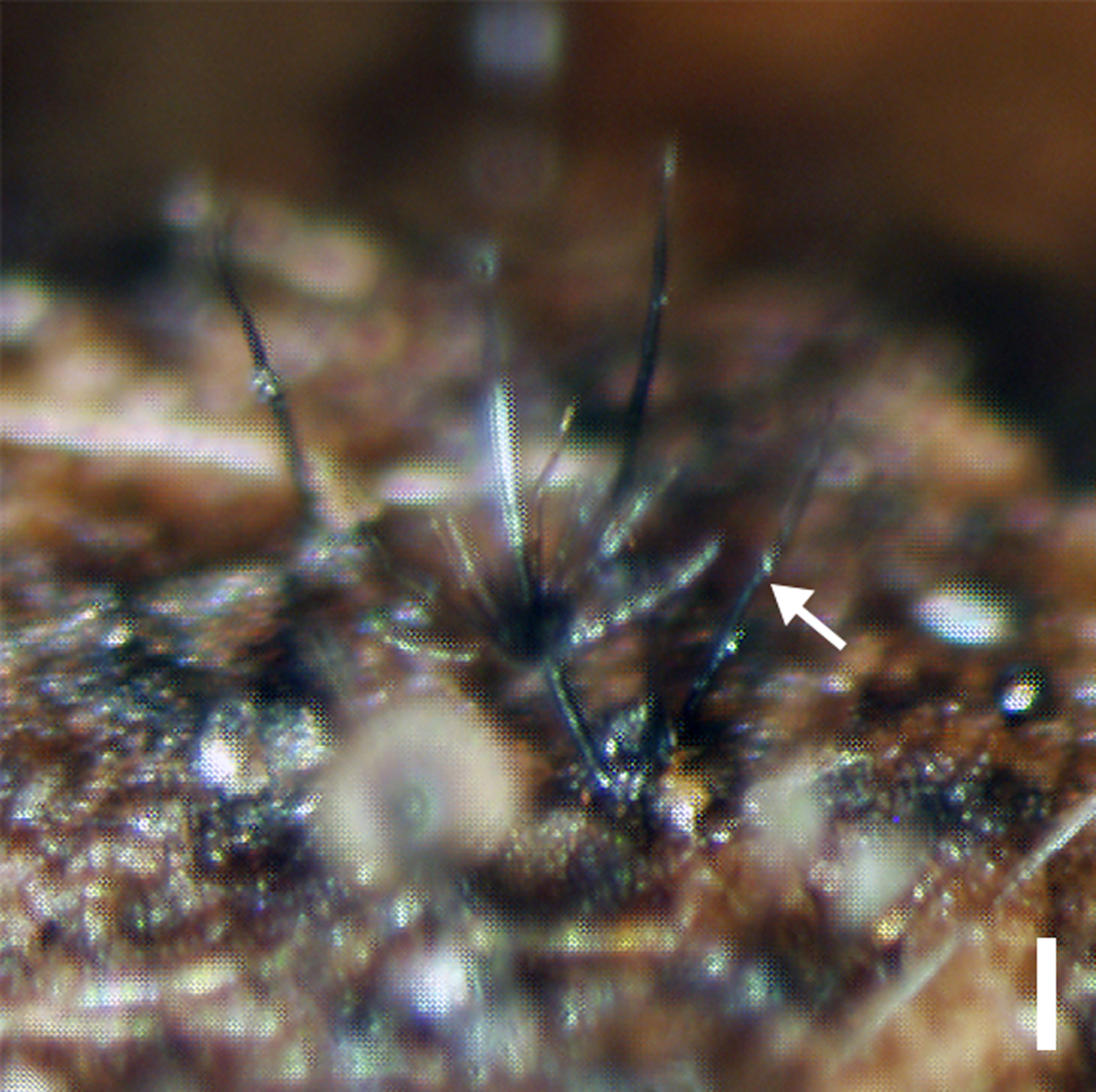Abstract
Species of Kionochaeta are saprobes commonly associated with decaying plant materials. As a part of surveys on freshwater microfungi, Kionochaeta-like taxon was found on a submerged decaying twig at a rivulet in the protected forest area of Khao Kheow Open Zoo (KKOZ), eastern Thailand. This taxon is microscopically similar to Kionochaeta, but clearly differs by its accessory lateral setiform branches and sterile setae arising beside the conidiophores. Multi-locus phylogenies inferred from four combined loci (SSU, ITS, LSU and RPB2) demonstrated that this taxon clustered as a unique clade with Kionochaeta species (Chaetosphaeriaceae, Chaetosphaeriales). Therefore, we introduce this taxon as K. setosimplicia, and it is phylogenetically close to K. castaneae, K. ramifera and K. pughii. Kionochaeta setosimplicia is separated from K. microspora and K. spissa. In Kionochaeta clade 1, K. nanophora forms a basal taxon. Kionochaeta ivoriensis forms a distinct Kionochaeta clade 2 distant from other Kionochaeta.
References
Chaiyarat, R., Saengpong, S., Tunwattana, W. & Dunriddach, P. (2017) Habitat and food utilization by banteng (Bos javanicus d’Alton, 1823) accidentally introduced into the Khao Khieo-Khao Chomphu Wildlife Sanctuary, Thailand. Mammalia 82. https://doi.org/10.1515/mammalia-2016-0121
Chuaseeharonnachai, C., Suetrong, S., Nuankaew, S., Somrithipol, S., Hongsanan, S., Srikitikulchai, P., Jones, E.B.G. & Boonyuen, N. (2020) Synnematotriadelphia gen. nov. (S. stilboidea comb. nov. and S. synnematofera comb. nov.) and Triadelphia hexaformispora sp. nov. in the family Triadelphiaceae. Mycological Progress 19. https://doi.org/10.1007/s11557-019-01547-6
Goh, T.K. & Hyde, K.D. (1997) The generic distinction between Chaetopsina and Kionochaeta, with descriptions of two new species. Mycological Research 101: 1517–1523. https://doi.org/10.1017/S0953756297004292
Hall, T. (1999) BioEdit computer program. Version 7.0.9. Available from: http://www.mbio.ncsu.edu/BioEdit/bioedit.html (accessed 15 June 2021)
Index Fungorum (2021) Available from: www.indexfungorum.org. (accessed 6 March 2021)
Jangtarwan, K., Koomgun, T., Prasongmaneerut, T., Thongchum, R., Singchat, W., Tawichasri, P., Fukayama, T., Sillapaprayoon, S., Kraichak, E., Muangmai, N., Baicharoen, S., Punkong, C., Peyachoknagul, S., Duengkae, P. & Srikulnath, K. (2019) Take one step backward to move forward: Assessment of genetic diversity and population structure of captive Asian woolly-necked storks (Ciconia episcopus). PloS one 14: e0223726–e0223726. https://doi.org/10.1371/journal.pone.0223726
Jintanugool, J. (1988) Wildlife sanctuaries in Thailand. ?????????????? 7: 382–400.
Katoh, K., Rozewicki, J. & Yamada, K.D. (2019) MAFFT online service: multiple sequence alignment, interactive sequence choice and visualization. Briefings in Bioinformatics 20: 1160–1166. https://doi.org/10.1093/bib/bbx108
Kirk, P.M. (1985) New or interesting microfungi. XIV. Dematiaceous Hyphomycetes from Mt Kenya. Mycotaxon 23: 305–352.
Kirk, P.M. & Sutton, B.C. (1985) A reassessment of the anamorph genus Chaetopsina (Hyphomycetes). Transactions of the British Mycological Society 85: 709–717. https://doi.org/10.1016/S0007-1536(85)80267-9
Kuthubutheen, A.J. & Nawawi, A. (1988) Two new species of Kionochaeta (Hyphomycetes) and K. ramifera from Malaysia. Transactions of the British Mycological Society 90: 437–444. https://doi.org/10.1016/S0007-1536(88)80153-0
Kuthubutheen, A.J. & Nawawi, A. (1994) Cryptophialoidea fasciculata sp. nov. and C. manifesta comb. nov. from Malaysia. Mycological Research 98: 686–688. https://doi.org/10.1016/S0953-7562(09)80417-6
Lin, C.G., McKenzie, E.H.C., Liu, J.K., Jones, E.B.G. & Hyde, K.D. (2019) Hyaline-spored chaetosphaeriaceous hyphomycetes from Thailand and China, with a review of the family Chaetosphaeriaceae. Mycosphere 10: 655–700. https://doi.org/10.5943/mycosphere/10/1/14
Liu, Y., Whelen, S. & Hall, B.D. (2000) Phylogenetic relationships among Ascomycetes: evidence from an RNA polymerse II subunit. Molecular biology and evolution 16: 1799–1808. https://doi.org/10.1093/oxfordjournals.molbev.a026092
Matsushima, T. (1971) Microfungi of the Solomon Islands and Papua-New Guinea. Matsushima, Kobe.
Maxwell, J.F. (1980) Vegetation of Khao Khieo game sanctuary Chonburi province, Thailand. Natural History Bulletin of the Siam Society 28: 9–24.
Miller, M.A., Pfeiffer, W. & Schwartz, T. (2010) Creating the CIPRES Science Gateway for inference of large phylogenetic trees. In: 2010 Gateway Computing Environments Workshop (GCE). https://doi.org/10.1109/GCE.2010.5676129
Réblová, M., Nekvindová, J., Fournier, J. & Miller, A.N. (2020) Delimitation, new species and teleomorph-anamorph relationships in Codinaea, Dendrophoma, Paragaeumannomyces and Striatosphaeria (Chaetosphaeriaceae). MycoKeys 74: 17–74. https://doi.org/10.3897/mycokeys.74.57824
Robert, V., Vu, D., Amor, A.B.H., van de Wiele, N., Brouwer, C., Jabas, B., Szoke, S., Dridi, A., Triki, M., Daoud, S. ben, Chouchen, O., Vaas, L., de Cock, A., Stalpers, J.A., Stalpers, D., Verkley, G.J.M., Groenewald, M., dos Santos, F.B., Stegehuis, G., Li, W., Wu, L., Zhang, R., Ma, J., Zhou, M., Gorjón, S.P., Eurwilaichitr, L., Ingsriswang, S., Hansen, K., Schoch, C., Robbertse, B., Irinyi, L., Meyer, W., Cardinali, G., Hawksworth, D.L., Taylor, J.W. & Crous, P.W. (2013) MycoBank gearing up for new horizons. IMA Fungus 4: 371–379. https://doi.org/10.5598/imafungus.2013.04.02.16
Sri-indrasutdhi, V., Boonyuen, N., Suetrong, S., Chuaseeharoonachai, C., Sivichai, S. & Jones, E. (2010) Wood-inhabiting freshwater fungi from Thailand: Ascothailandia grenadoidia gen. et sp. nov., Canalisporium grenadoidia sp. nov. with a key to Canalisporium species (Sordariomycetes, Ascomycota). Mycoscience 51: 411–420. https://doi.org/10.1007/S10267-010-0055-6
Stamatakis, A. (2014) RAxML Version 8: A Tool for Phylogenetic Analysis and Post-Analysis of Large Phylogenies. Bioinformatics 30. [Oxford, England] https://doi.org/10.1093/bioinformatics/btu033
Storer, J.P. (1979) A Preliminary Biological Survey of Khao Khieo. pp. 25–46.
Swofford, D. (2002) PAUP*. Phylogenetic Analysis Using Parsimony (*and Other Methods). Version 4.0b10.
Vilgalys, R. & Hester, M. (1990) Rapid genetic identification and mapping of enzymatically amplified ribosomal DNA from several Cryptococcus species. Journal of Bacteriology 172: 4238–4246. https://doi.org/10.1128/jb.172.8.4238-4246.1990
White, T., Bruns, T., Lee, S., Taylor, J., Innis, M., Gelfand, D. & Sninsky, J. (1990) Amplification and direct sequencing of fungal ribosomal RNA genes for phylogenetics. In: Innis, M., Gelfand, D., Sninsky, J. & White, T.J. (Eds.) PCR protocols: a guide to methods and applications. Academic Press, San Diego, CA, pp. 315–322. https://doi.org/10.1016/B978-0-12-372180-8.50042-1
Yang, J., Liu, J.K., Hyde, K.D., Bhat, D.J., Jones, E.B.G. & Liu, Z.Y. (2016) New species of Sporoschisma (Chaetosphaeriaceae) from aquatic habitats in Thailand. Phytotaxa 289 (2): 147–157. https://doi.org/10.11646/phytotaxa.289.2.4
Yang, J., Liu, N.G., Liu, J.K., Hyde, K.D., Jones, E.B.G. & Liu, Z.Y. (2018) Phylogenetic placement of Cryptophiale, Cryptophialoidea, Nawawia, Neonawawia gen. nov. and Phialosporostilbe, Mycosphere 9 (6): 1132–1150. https://doi.org/10.5943/mycosp


